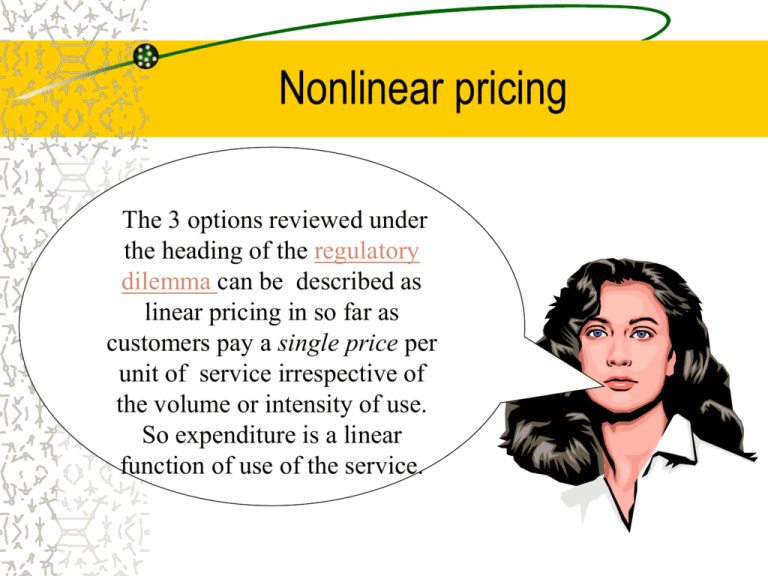Nonlinear pricing
advertisement

Nonlinear pricing The 3 options reviewed under the heading of the regulatory dilemma can be described as linear pricing in so far as customers pay a single price per unit of service irrespective of the volume or intensity of use. So expenditure is a linear function of use of the service. 2 part tariff A two-part tariff is nonlinear and consists of a fixed amount or fee (i.e., it does not vary with the level of consumption) plus a per unit charge for the service. If the per unit charge is equal to marginal cost, then it is possible to have socially efficient pricing and give a fair rate of return to the regulated firm. Audio explanation (wav) D = AR J 0.12 0.10 0 K LAC LMC 20,000 KWHs Example Let F be the Fixed Fee imposed on electric utility customers and R is the rate per KWH. Thus, the utility bill of customer X is given by: Utility BillX = F + (R • KWHsX) Notice from the graph that the per unit loss under the marginal cost pricing option is $0.02. Therefore: Total Losses = $0.02 • 20,000 MWHs = $400.00 Let F = k/n, where k is total losses under a marginal cost pricing regime and n is the number of customers. If n = 20, then: F = $400/20 = $20.00 So every customer will pay a fixed fee of $20.00, regardless of electricity use. Thus the utility bill of customer X is given by: Utility BillX = $20.00 + ($0.10 • KWHsX) If no consumer is "excluded" from the market by the fixed fee, then total market expenditure (TE) is equal to total cost (TC): TE = $400 + [($0.10)(20,000)] = $2,400 Final notes on 2-part tariffs The problem with nonlinear pricing is that the fixed fee may have the effect of pushing the actual or "effective" price per KWH above the reservation price for some users--especially small or low-income users. Hear audio explanation (wav). If the fixed fee is exclusionary, then the nonlinear pricing schedule does not measure up to marginal cost pricing on efficiency grounds. Multipart tariff Multipart tariffs (or declining block pricing) are widely used among regulated firms. Under a multipart tariff, price per unit of service falls in blocks as usage increases. Multipart tariff for local phone service Phone Bill ($) 20 C D B 10 5 0 A 100 200 Calls/Month Notes on figure Customers pay a fixed fee per month = $5.00 + $0.10 per call for calls up to 100 + $0.05 per call for calls between 100 and 200 + $0.00 per call for all calls above 200 If you make 100 calls, your phone bill is $15.00. If you make 200 calls, you bill is $20.00. If you make 300 calls, you bill is $20.00. Total expenditure function is given by TE = ABCD Hence the function is nonlinear. Why is a multipart tariff a good idea? Distribution of telephone service, e.g., is subject to economies of scale. Diminishing prices at the margin stimulate consumption, which in turn permits the construction of large scale capacity. Back to Lesson 11






